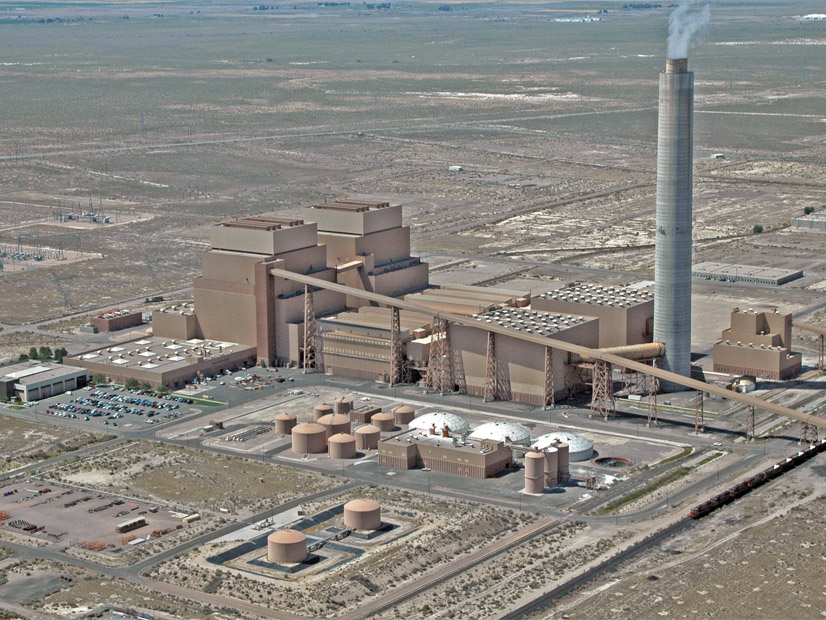PJM is looking to create guidance and requirement language for several manuals related to the implementation of a dynamic line rating (DLR) system in the RTO.
Chris Callaghan, senior business solution engineer with PJM’s applied innovation department, presented a first read of a problem statement and issue charge at last week’s Operating Committee meeting.
Transmission lines are typically operated using a static rating calculated for periods of time using near worst-case values for predicted weather conditions, but DLRs can be calculated in real time and show the resulting weather and other environmental impacts to the line ratings.
Callaghan said DLR deployments in PJM will involve the installation of a data collection sensor on or near an existing transmission line to collect real-time conductor temperature information. The sensor technologies that will be deployed in PJM include weather stations, electromagnetic field detectors and thermal cameras.
While different sensor technologies exist, Callaghan said, PJM wants to see the DLR installation projects have a common goal of targeting congested transmission facilities where the conductor is the most limiting element.
PJM has identified several manuals that may require new language for the incorporation of DLRs. The updates include section 2 of Manual 1 related to member control center requirements, section 2 of Manual 3 on thermal operating guidelines and appendix A of Manual 3A on the transmission equipment rating monitor equipment ratings update process.
The proposed problem statement calls for the incorporation of supporting manual language to ensure the “efficient and reliable operation” and use of equipment DLR systems in various aspects of operations, markets and planning. Callaghan said the opportunities driving the effort include reliability and economic benefits associated with DLR technology.
Adrien Ford, ODEC
” data-credit=”© RTO Insider LLC” style=”display: block; float: none; vertical-align: top; margin: 5px auto; text-align: left; width: 200px;” alt=”DER PJM withholding requests for proposals” align=”left”>Adrien Ford, ODEC | © RTO Insider LLC
“The interest here is transparency to members and the reliability mission of PJM,” Callaghan said.
Expected deliverables in the issue charge include stakeholder education of DLRs and potential new or modified governing language in the manuals.
Callaghan said PJM was looking to use the “CBIR Lite” (Consensus Based Issue Resolution) process to come up with a single proposal. The discussions would occur at normal OC meetings and are expected to take more than two months.
Adrien Ford of Old Dominion Electric Cooperative said she disagreed with using the CBIR Lite process and had anticipated more expected deliverables and key work activities in the issue charge. Ford said PJM should be “very careful” to keep the issue narrow if the RTO wants the DLR work done quickly in the OC.
Calpine’s David “Scarp” Scarpignato said he was hoping for a deliverable focused on the placement of DLRs on the grid. Scarp said DLRs are “very important to modernize the transmission grid,” but it will be necessary to make sure their placement is not discriminatory.
Sharon Midgley, Exelon
” data-credit=”© RTO Insider LLC” style=”display: block; float: none; vertical-align: top; margin: 5px auto; text-align: left; width: 200px;” alt=”Midgley-Sharon-2019-03-06-RTO-Insider-FI.jpg” align=”left”>Sharon Midgley, Exelon | © RTO Insider LLC
Scarp also said he doesn’t know what criteria and guidelines transmission owners plan to use for the installation of DLRs. “I think an important expected deliverable has to be criteria for where to implement DLR.”
Eric Hsia of PJM said the RTO recognizes the importance of DLR placement. Hsia said PJM wanted to focus on adding support language on the physical operations of DLR in the proposed problem statement and issue charge and that the DLR placement issue could better be handled at the Planning Committee in a separate problem statement and issue charge.
Sharon Midgley of Exelon said PJM should be “very careful” in doing a legal review to “respect” the delineation of responsibilities between the TOs and the RTO when it comes to decisions on the placement of DLRs on the transmission system.
“I get a little nervous when I hear things like new requirements and new criteria,” Midgley said.
The OC will be asked to approve the issue charge at the Jan. 13 meeting.
Renewable Dispatch First Read
Darrell Frogg of PJM’s generation department, presented a first read of a problem statement and issue charge to improve dispatching renewable resources and increase forward-looking visibility.
Frogg said PJM is already discussing renaming the issue to “intermittent resource dispatch” instead of “renewable dispatch” to better align with existing language in the RTO’s governing documents. Frogg said PJM wanted to keep the issue broad to include all renewable resources.
The growing number of renewable resources on the grid has led to some “new operational issues and impacted existing issues,” Frogg said, including a greater dependence on the ability to accurately dispatch renewable resources in real time and forecast near-term changes. Frogg said as the number of renewable resources grows, manually managing dispatch becomes more difficult and leads to inconsistent performance when following curtailments and/or basepoints.
Frogg said PJM sees an opportunity to improve several main aspects of renewable dispatch, including developing a method that covers all renewable resources and a streamlined data exchange.
The key work activities of the issue charge include reviewing education on the existing renewable dispatch practices and the expectations from PJM and its members. The goal is to propose solutions to enhance the overall renewable dispatch process.
Areas in scope for discussion in the issue charge are the methods in which PJM dispatches renewable resources, communication of dispatch mode and instructions, and lost opportunity cost eligibility. Out-of-scope items include existing market products and calculations and ongoing revisions such as those related to FERC Order 2222 and the treatment of solar-battery hybrids. (See “Solar-battery Hybrid Resources,” PJM MRC/MC Briefs: Nov. 17, 2021.)
The expected deliverables in the issue charge are changes to resource expectations when dispatched in real time and manual language and potential governing document changes to reflect the proposal.
Work on the issue charge would take place in the OC or its special sessions, reporting out to Market Implementation Committee when needed. The work is estimated to take six months, and PJM was looking to pursue the CBIR Lite approach to develop a proposal.
David "Scarp" Scarpignato, Calpine
” data-credit=”© RTO Insider LLC” style=”display: block; float: none; vertical-align: top; margin: 5px auto; text-align: left; width: 200px;” alt=”dave-scarpignato-rto-insider” align=”left”>David “Scarp” Scarpignato, Calpine | © RTO Insider LLC
Scarp said he didn’t think the issue should be part of the CBIR Lite approach. He said PJM staff are “extremely well versed” on the issue and think it can be solved quickly, but the stakeholder process can take longer as members need to be brought up to speed on complicated issues.
“We may end up at the same positions as PJM, but we have to have time to get there in order to vote for it,” Scarp said.
Sean Chang of Shell Energy said he would like to see some education on comparing what other RTOs and ISOs are doing on the renewable dispatch issue.
“Some of the other areas with more renewable penetration have had some challenges operationally, and it could be helpful to compare and contrast,” Chang said.
The OC will be asked to approve the issue charge at its next meeting.
Manual 38 Changes
Liem Hoang of PJM reviewed proposed changes to Manual 38: Operations Planning as a part of a periodic review during a first read.
Hoang said the minor changes include updating the Eastern Interconnection Reliability Assessment Group study and PJM participation in the group. Language was added to state that the group will conduct “assessments to identify key reliability issues and the risks and uncertainties affecting adequacy and security of the bulk power system in the Eastern Interconnection.”
The OC will be asked to endorse the changes at its Jan. 13 meeting, with final adoption at the Markets and Reliability Committee meeting Jan. 26.







